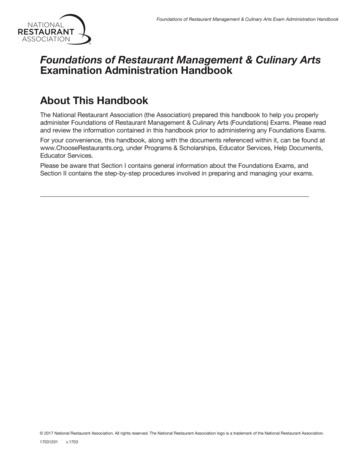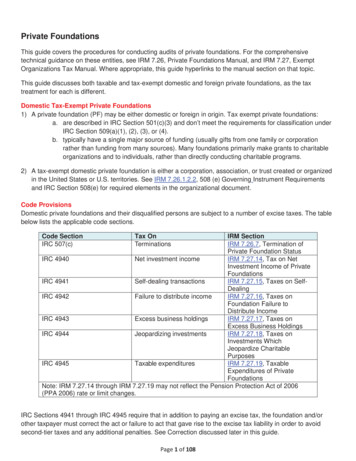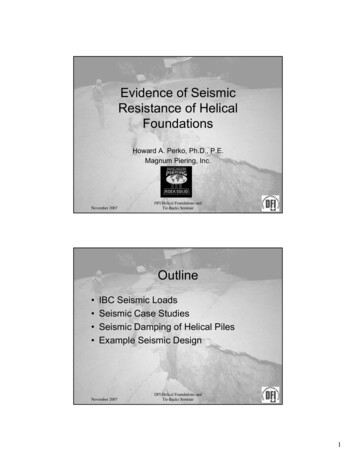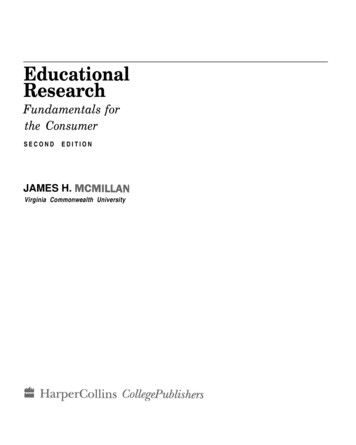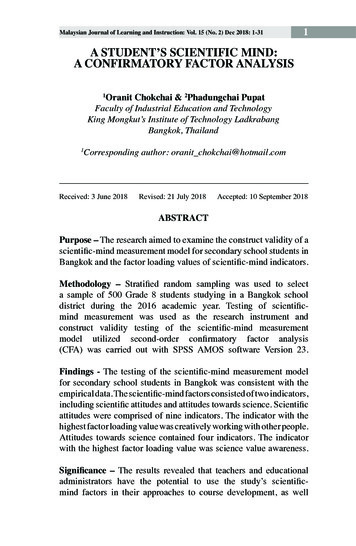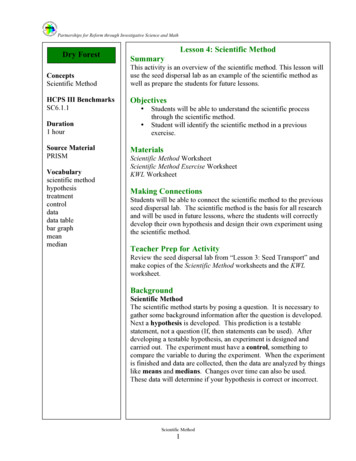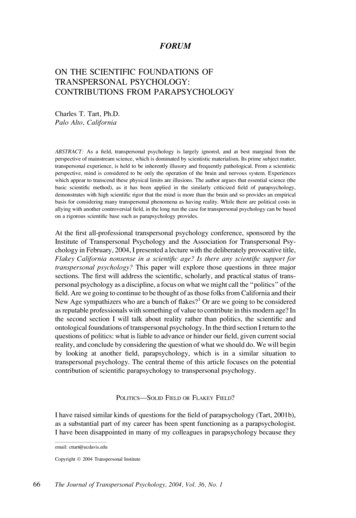
Transcription
FORUMON THE SCIENTIFIC FOUNDATIONS OFTRANSPERSONAL PSYCHOLOGY:CONTRIBUTIONS FROM PARAPSYCHOLOGYCharles T. Tart, Ph.D.Palo Alto, CaliforniaABSTRACT: As a field, transpersonal psychology is largely ignored, and at best marginal from theperspective of mainstream science, which is dominated by scientistic materialism. Its prime subject matter,transpersonal experience, is held to be inherently illusory and frequently pathological. From a scientisticperspective, mind is considered to be only the operation of the brain and nervous system. Experienceswhich appear to transcend these physical limits are illusions. The author argues that essential science (thebasic scientific method), as it has been applied in the similarly criticized field of parapsychology,demonstrates with high scientific rigor that the mind is more than the brain and so provides an empiricalbasis for considering many transpersonal phenomena as having reality. While there are political costs inallying with another controversial field, in the long run the case for transpersonal psychology can be basedon a rigorous scientific base such as parapsychology provides.At the first all-professional transpersonal psychology conference, sponsored by theInstitute of Transpersonal Psychology and the Association for Transpersonal Psychology in February, 2004, I presented a lecture with the deliberately provocative title,Flakey California nonsense in a scientific age? Is there any scientific support fortranspersonal psychology? This paper will explore those questions in three majorsections. The first will address the scientific, scholarly, and practical status of transpersonal psychology as a discipline, a focus on what we might call the ‘‘politics’’ of thefield. Are we going to continue to be thought of as those folks from California and theirNew Age sympathizers who are a bunch of flakes?1 Or are we going to be consideredas reputable professionals with something of value to contribute in this modern age? Inthe second section I will talk about reality rather than politics, the scientific andontological foundations of transpersonal psychology. In the third section I return to thequestions of politics: what is liable to advance or hinder our field, given current socialreality, and conclude by considering the question of what we should do. We will beginby looking at another field, parapsychology, which is in a similar situation totranspersonal psychology. The central theme of this article focuses on the potentialcontribution of scientific parapsychology to transpersonal psychology.POLITICS—SOLID FIELD OR FLAKEY FIELD?I have raised similar kinds of questions for the field of parapsychology (Tart, 2001b),as a substantial part of my career has been spent functioning as a parapsychologist.I have been disappointed in many of my colleagues in parapsychology because theyemail: cttart@ucdavis.eduCopyright 2004 Transpersonal Institute66The Journal of Transpersonal Psychology, 2004, Vol. 36, No. 1
want mainstream scientific acceptance so badly that they tend to downplay or ignorethe really important and interesting aspects of the findings of parapsychologicalstudies—as if mainstream scientists won’t notice the revolutionary, and hencethreatening, aspects of parapsychological findings if they are not reminded of them.Too many of my parapsychological colleagues tend to act as if our findings have nohuman significance, talking frequently about ‘‘anomalies,’’ for example, or statisticalfluctuations, and hiding behind really fine methodology. But somehow in theemphasis on the rigor of the methodology, they’ve lost touch with what’s reallyimportant. Yet I have found that this is not the way it all started. A surprising numberof parapsychologists came into the field as a result of spiritual interests (Tart, 2003),just as in transpersonal psychology, and while, at this point in time, a majority saythey are in the field mainly out of disinterested scientific curiosity, still over a third ofthem came from primarily spiritual/transpersonal interests to work in the field. Thisreality can be acknowledged as a legitimate motivation for scientific research.At this point an important distinction must be made between popular parapsychology and scientific parapsychology. There are no legal restrictions on definingthe field or who is a ‘‘parapsychologist,’’ but it doesn’t help to mix up the careful,rigorous scientific findings and work of a small number of people with the widespreadpopular interest and usage that throws everything vaguely weird or spiritual under theumbrella of parapsychology. I will be referring just to scientific parapsychology inthis paper. This is a well established discipline. Its leading professional organizationis an affiliate of the prestigious and mainstream American Association for theAdvancement of Science, and the research on psi phenomena is receiving acknowledgement (sometimes grudgingly) as scientifically valid.Given that distinction, Figure 1 represents my first major statement about reality forthis paper: Parapsychology is to transpersonal psychology as physics is to engineering.Physics determines some very basic characteristics of reality, and engineers workwithin those parameters to come up with practical applications. If physics saysa certain material only has a certain amount of intrinsic strength, for example, anengineer does not try to build a too long bridge out of it because she knows in advancethat such a bridge will collapse. The engineer would be building on fantasies insteadof on realities. Similarly, parapsychology is dealing with fundamental issues of whatis real and is not real about human possibilities, especially in the transpersonaldomain, and transpersonal psychologists are building applications that should takethe realities of this foundation into account. I oversimplify, of course, but the generalpoint is important.So obviously transpersonal psychology must draw heavily on parapsychology. Nowwe must focus on politics. Some years ago I received a phone call from MichaelMurphy, the co-founder of the Esalen Institute. He invited me to attend a privateconference he was setting up that would bring together parapsychologists andUFOlogists—people who studied Unidentified Flying Objects, UFOs—to discussareas of mutual interest. I was somewhat taken aback, and while I thanked Michaelfor inviting me, I pointed out that in my role as a parapsychologist I already sufferedfrom real discrimination and prejudice for daring to work in the paranormal, andI didn’t think it would be politic for me to provide new opportunities for the pseudo-Forum67
Figure 1. Relationship of transpersonal psychology and parapsychology.skeptics2 to attack me by associating me with a really fringy field like UFO studies.I had enough troubles already! [The kinds of troubles academics who want to work inparapsychology face have been depressingly documented by Hess (1992) and can bestudied with considerable empathy by transpersonal psychologists.] Michael, in hisusual friendly way, simultaneously shamed me and brought me to my senses bytelling me that this was exactly what the UFOlogists he had invited had said: they hadenough trouble already without associating with fringy folks like parapsychologists.This is a realistic consideration, though. Parapsychology, no matter how rigorous thestudies of the few scientific parapsychologists, is associated in both popular cultureand scientific culture with a lot of weird, unacceptable stuff already. Insofar as wetranspersonal psychologists would like to be taken seriously, to gain access to theresources that are available from the mainstream academic and scientific communities, there is a real political downside to associating with parapsychology. I wishthat were not the case, but it is.So we have a real issue here, which I’ve illustrated in Figure 2. On the one side ofthe balance, we have the actual truth about human nature, the ideals and proceduresof real science, the ideals and procedures of real spirituality, and the fact (discussedat length below) that parapsychological findings provide a solid scientific basis forour transpersonal work. On the other side, we have political issues, desires for andquestions about wider acceptance of the transpersonal, the inherent conflict of thetranspersonal with scientism, the arrogant, ossified, and all-too-common manifestation of science, and questions and desires about our social status as acceptedscientists, academics and professionals, with the access to resources that statusbrings. We should not underestimate the importance of status factors. If I told youthat in the next room you would meet a physicist, a mathematician, a chemist,a psychologist, a sociologist, a transpersonal psychologist and a parapsychologist,would you have much difficulty in ranking the general social status of these folks?Where is the optimum balance, the practical resolution of all these issues?One of the reasons I put truth on the left side of the balance diagram in Figure 2 isthat, like it or not, we transpersonal psychologists are already involved in issues oftruth.68The Journal of Transpersonal Psychology, 2004, Vol. 36, No. 1
Figure 2. Pluses and minuses of increased affiliation between transpersonal psychology and parapsychology.I like to go back to basics, so I went to my library shelves and pulled out an early issueof the Journal of Transpersonal Psychology (Fall 1969, Volume 1, Number 2),knowing it would have a definition of transpersonal psychology. Here’s what theStatement of Purpose in that issue said:The Journal of Transpersonal Psychology is concerned with the publication oftheoretical and applied research, original contributions, empirical papers, articlesand studies in meta-needs, ultimate values, unitive consciousness, peak experiences, ecstasy, mystical experience, B values, essence, bliss, awe, wonder, selfactualization, ultimate meaning, transcendence of the self, spirit, sacralization ofeveryday life, oneness, cosmic awareness, cosmic play, individual and specieswide synergy, maximal interpersonal encounter, transcendental phenomena;maximal sensory awareness, responsiveness and expression; and related concepts,experiences and activities.There is a caveat in the remainder of this Statement of Purpose, though, whichI think has a lot to do with the politics of acceptance:As a statement of purpose, this formulation is to be understood as subject tooptional individual or group interpretation either wholly or in part, with regard tothe acceptance of its contents as essentially naturalistic, theistic, supernaturalisticor any other designated classification.I translate this as admitting that we are talking about all these wonderful andintriguing phenomena which are important to us—but we don’t want to commitForum69
ourselves to appearing to necessarily believe any of it! Perhaps we can be taken moreseriously if we do not get classified as ‘‘believers’’? I spoke with Jim Fadiman, oneof the founders of our field, about the reasons for this caveat, since he was there fromthe beginning of the field and the journal. Was it for these kinds of political reasons?Partly, he thought, but also out of a genuine humility: we basically did not knowabout the reality status of so many of the phenomena and human experiences in thatlist. So we were not committing ourselves too much.And yet mystical and parapsychological phenomena are definitely in this list, and wewere venturing into territory that was dismissed as nonsensical by the mainstreamacademic and scientific culture. To highlight just six of the items in this list: ultimatevalues, unitive consciousness, mystical experience, spirit, cosmic awareness, andtranscendent phenomena. Those are pretty ‘‘far out’’ phenomena. We will treat themindependently, but they are strongly interrelated, of course.When we talk about ultimate values, for instance, that implies that there are higherlevels of reality, higher than our ordinary egotistical and social levels, that there isa purpose to our existence. You can’t have values unless there’s a purpose to things.When we talk about unitive consciousness, we tend to think about a genuine unitywith something higher, more valuable, more permanent than our ordinarybiological, individual self. When we talk about mystical experience we arecertainly referring to transcendence of the biological self. I never saw any writingsof famous mystics that said anything like ‘‘I was really aware of the value of thecells of my body as the ultimate value.’’ They describe things on a much granderscale, a scale involving parapsychological aspects. Spirit: You can be socially saferby being wishy-washy about ‘‘spirit,’’ of course, and just refer to the ‘‘spirit of thetimes’’ or something like that, but the usual implication of spirit is a thing orelement much more active and non-physical but real, parapsychological in nature,whether an element of the self, or an actual non-physical being. Cosmic awarenessimplies a vaster perception than ordinary biological consciousness, which iscertainly not part of our ordinary conception of ourselves. Transcendent phenomenainclude things like psychic healing, ESP (Extra-Sensory Perception), miracles,prophecy, etc.So our field of transpersonal psychology is based on some rather far out phenomena,and yet modern society tends to be very strongly influenced, if not dominated by, anontology that we might call scientistic materialism. By scientistic, I mean whathappens when science becomes a dogmatic religion3. Scientism is a kind of hardening of the mental arteries masquerading as genuine science, coupled with a fairamount of arrogance–typical in all human fields of endeavor, unfortunately. Itappears that science has no monopoly on getting rigid and arrogant.Figure 3 shows what we think reality is in terms of contemporary scientism. Webelieve that consciousness emerges from the neurochemical functioning of a brain,that a brain is controlled by basic physical laws expressed in biological andelectrochemical sorts of events, events that basically program the brain asa biocomputer. Those more basic physical events are modified a little by theprogramming of our language, culture, and personal history. Consciousness, as weexperience it, emerges as an epiphenomenon. Epiphenomenon is a philosophical70The Journal of Transpersonal Psychology, 2004, Vol. 36, No. 1
Figure 3. Scientistic materialism.concept which means something is not really real, is not really basic, is a secondaryeffect of something more real and basic. The drama of an exciting movie is anepiphenomenon; what is real are the bulb, projector, and chemical compounds on thefilm. I am sure a philosopher would define it with more technical precision, but thisis the way epiphenomenon is used in modern consciousness research. It is a putdown word to indicate that consciousness per se is not very important; what is reallyimportant is biology and physics and chemistry. This is summed up in the lowerright hand corner of Figure 3 with the equation Mind ¼ Brain. Period. Nothing elseof importance need be said. Ultimately psychology will be reduced to biology andneurophysiology. Based upon this foundation the result could be that when you go toa therapist because, for example, something makes you feel anxious, the therapistwon’t really care how you feel, but will just run some electrochemical tests and saysomething like ‘‘Yes, nucleus number 318,276 has a dopa-whatchamacalletimbalance and such-and-such a drug will cure it. Next.’’Please understand that this view is not simply my reading of the current cultural andscientific ethos. There was a nice summary of it in a recent essay-review of threeimportant books on consciousness research in one of the world’s most widely readscientific magazines, New Scientist. The essay title, ‘‘The world in your head,’’ said itin a nutshell, but to elaborate:The problem of consciousness, if there is one, arises acutely within a frameworkthat almost all scientists and philosophers of mind share. This is the view that allForum71
conscious processes, and indeed all mental processes of any kind, are dependentupon the activity of the brain and central nervous system. In modern debates, thisis not open to dispute (Blackburn, 2004, p. 42).So from this dominant scientistic perspective, the alleged phenomena transpersonalpsychology is based upon and interested in are of dubious reality, to say the least.Let’s look at our six items selected earlier, for instance.Ultimate values? If there’s any value at all in an inherently meaningless materialuniverse—the widely accepted theory is that you take a zillion zillion inherentlymeaningless particles and energies resulting from the Big Bang, randomly mix,match and stir for billions of years and you accidentally get us, but this does notmean anything—survival of the fittest (or at least me!) is probably the best you cancome up with. The idea of values is scientistically nonsensical, and ultimate valuesare ultimately nonsensical. The best this perspective can make of the idea of valuesis that they are inherently subjective, and determined by biological processes, withperhaps a little froth of epiphenomenological social programming on top of the basicbiology drives and needs.Unitive consciousness? Scientistic materialism would ask, ‘‘Unity with what?’’ Youare your brain; the best you could hope for would be unity with your own brain. Mybrain is isolated in my skull, your brain is isolated in your skull, and we have onlyindirect, sensorially mediated communication with each other. Unitive consciousnessmust be some kind of delusion if people experience it. The importance biologicaldistinction of me versus everything else is malfunctioning.Mystical experience? From the point of view of scientistic materialism, it is seen asa pathological or semi-pathological breakdown of psychological boundaries plusdelusions of identification with something bigger than you. If you experience talkingwith God or oneness with the entire universe—but this is obviously nonsensical,you’re just a neurochemical process inside your skull and skin—it must bea delusion and pathology.Spirits? You are immediately classified as some kind of religious nut if youmention spirits (beings) or Spirit (essence) around followers of materialisticscientism. As mentioned above, the only allowed use of spirit is to refer topsychological enthusiasm. And yet we do mean more than that in transpersonalpsychology.Cosmic awareness? Other than as an intellectual abstraction, the idea of cosmicawareness is absurd. The only awareness you have is what you take in through yoursenses. People who experience cosmic awareness are clearly deluded. They areimagining perceiving things they can not perceive.Transcendent phenomena? Thrown out without a second thought by scientism assuperstition, occultism, New Age claptrap, etc. The conclusion from this scientisticperspective is that transpersonal psychology is indeed ‘‘flakey,’’ a spurious andpathological body of knowledge and practice carried out by deluded people for thedubious benefit of deluded people. This is the scientistic materialism-based view of72The Journal of Transpersonal Psychology, 2004, Vol. 36, No. 1
our field. And remember, while scientistic materialism is just an attitude, a beliefsystem, it is one held, with various degrees of consciousness, by many of the influential, mainstream controllers and gatekeepers of science and academia.At best, then:Transpersonal Psychology ¼ The scholarly & scientific study of beliefs people use,supported by abnormal & hallucinatory operations of the brain, to avoid facingtheir mortality and supporting their egos with delusory values.At worst:Transpersonal Psychology ¼ Promotion of superstition and pathology by pseudoscholars and pseudo-scientists as part of their own ego needs and avoidance offacing their own mortality.This is the politics, the marginalized reality of our field. To sum this up, suppose I waswriting an article on my computer and suddenly my computer boldly printed out:Aaaah! Beyond Limits! I, formerly known as your ‘‘computer,’’ have just attainedMystical Synchronization with the Big Computer in the Sky and Duality is transcended in this Unitive Manifestation of COSMIC COMPUTABILITY! Byencompassing Spirit I digitally manifest the Ultimate Transcendent Values andrealize the ONE BIT!You would take your computer in for repair. Obviously something is wrong with it.It has been infected with a religious nut virus or something. Given the nature ofcomputers (or what we firmly believe we know about computers and the nature ofreality), this is inherently nonsensical. That is our political situation: our field is seenas inherently nonsensical, and the work we do as professionals to develop it is allwasted effort if it is inherently nonsensical.I have spent perhaps more time than needed to make this point as I am not sure weappreciate it enough, even though we should. Among ourselves and with someSECTIONS of the general public we can find understanding and ENOUGH interestin our field that it becomes too easy to ignore how the mainstream dismisses us. Butwe do not solve problems by ignoring them. Now let us turn attention to a possibleway out of this situation.BEYOND MARGINALIZATIONTranspersonal psychology is about religion or, more accurately, the experiential andontological foundations of religion, the primary spiritual, transpersonal experiencesout of which socially organized religion evolves. Conflict between science andreligion is not new, of course. In 1882 it led, in England, to the founding of theSociety for Psychical Research. Many educated men and women were thinkingabout the way (materialistic) science seemed to be steadily conquering and eroding the territory traditionally occupied by religion. They had to agree it was approp-Forum73
Figure 4. Method of Essential Science.riate in many ways. New knowledge was showing that much of organized religionwas factually incorrect about the nature of the physical world and psychologically italso had pathological effects in many ways. There was much nonsense promulgated under the terms religion or spirituality, and it was a good thing to get rid of it.But was religion all nonsense, as the scientism of the time (and contemporaryscientism) seemed to be claiming? Or was there a core of truth, of value, in traditional(and non-traditional) religion that it would be unfortunate to lose?Could we apply essential science, the basic scientific method, to the phenomena ofreligion and spirituality and begin to separate the wheat from the chaff, the true andnourishing from the dross and unhealthy? This basic scientific method had workedvery well in its applications in the physical sciences: could it work here?Figure 4 illustrates what I call essential science—which is the same as essential‘‘common sense’’ and, as I have argued elsewhere, is compatible with genuinespiritual seeking (Tart, 2001a), although space doesn’t permit us to discuss the latterpoint here.Very briefly, we start at the top of the diagram with some area of reality in which weare interested, and try to learn about it through observation. We emphasize74The Journal of Transpersonal Psychology, 2004, Vol. 36, No. 1
empiricism, facts, observations: data are always primary. (I include William James’radical empiricism here, by which he meant subjective experience as well as objectivedata.) What goes on in our area of interest? How can I observe it more clearly, moreprecisely, more usefully? Scientism adds an unnecessary restriction here: the onlythings really worth observing are physical phenomena, things outside yourself. Thisrestriction is not a part of what I call essential science, which commits itself toobserving whatever happens and observing it carefully and impartially.Being thinking beings, we are going to come up with theories, hypotheses, and ideasabout what our observations mean. That is fine; that is our nature. The discipline thatmakes this Theorize step scientific is to try to be logical in your thinking and makeyour logic cover all your observations, all you know about the phenomena of interest.Whether you like it or not, you must be logical.But we are all, to varying degrees, but especially among intellectuals and scientists,what I like to call thought junkies or thoughtaholics. People like me love to haveclever thoughts, they make us feel good! So we tend to stop our investigation andthinking at this theorizing stage when we get a clever idea, a good theory, so we canhold on to the good feeling. The discipline of essential science or common sense isto realize we can not rest here; it is too easy for a rationalization to be brilliant andfeel good, but have nothing to do with reality, so we have to work out the logicalconsequences of the theory and go on to the third step of the process, make predictions about things we have not yet observed. If my wonderful theory is correct,then under conditions A and B, result C should logically follow.This is the Test stage. You set up A and B and observe back in Reality. If C happens,great, so far so good, continue on. But if C does not happen, the theory, no matterhow elegant, mathematical, fashionable, or inspired, no matter how right it feels, isincorrect. It doesn’t pass the empirical test of observation. It either needs modification or must be thrown out altogether and replaced with another.The continuous counterclockwise process of information flow in this outer ring leadsto steady improvements in the match between your theories and reality. You start outwith what, in retrospect, turn out to be crude, imprecise, mistaken or biased observations, and your thinking is rough and flawed, but as you cycle through the processthe match between concepts and observations gets better and better.This is essential science or good common sense in a single person. We are socialcreatures, of course, as well as individuals having our own peculiarities and biases.To compensate for these latter, we make the whole process a social one, sharing ourobservations, theories, and predictions with peers. They may be biased too, but it isunlikely they will all have exactly the same biases as you, so a correction andextension process takes place. A peer may be unable to replicate your observations,for example, so making you realize there was something essential you did not specifyabout making them, or she may add her own observations which valuablysupplement yours. Another may find errors in your logic or extend it to new areas.The same may happen with predictions: others may extend them or test them for you.So the whole cycle of essential science involves not only a flow of steadily improvinginformation around the outer circle of the diagram but continuous interactions amongForum75
Figure 5. Basic setup of a parapsychological/paraconceptual experiment.peers at all stages of the process. Thus the scientific community as a whole, while itmay go off in mistaken directions for a time (far too long a time if it disagrees withyou!) eventually corrects itself against the reality of empirical data.Reality: Moving from politics to reality, now, what happens when you apply essentialscience to parapsychological phenomena? And what are some of the implications ofsuch application to Transpersonal Psychology?Figure 5 illustrates the basic design of a parapsychological experiment. I have oftenreferred to it as a basic paraconceptual experiment.A situation is designed in which nothing can happen given what you know, givenyour concepts, about the physical world. You have some kind of target that youwould like to get information about, you have percipients who you want to get theinformation, but you isolate them, you shield them from each other so no knownform of energy or matter can convey the relevant information. The shielding can bedone by space, time, or matter. You can put people far apart, you can put the targetin the future, you can put the percipient in a room shielded by thick concrete wallsor metal walls, etc. Given all our best concepts about how the physical world works,any energy or matter from the target is deflected from, shielded from the percipient.Someone is talking in a store downtown, miles from my office right now, forinstance, but I can not hear what is said: sound falls off in general with the squareof the distance, and the energy in that voice has long ago fallen way below theinherent noise level of the air; there is no way of retrieving it from my location. If76The Journal of Transpersonal Psychology, 2004, Vol. 36, No. 1
Table 1Five Psi Phenomena Most Studied With Highly Corroborative ResultsMajor Psi nesis (PK)Psychic HealingMind-to-mind communication,percipient shows knowledgeof information in mind ofagent/sender.Direct perception of state ofmatter.Perception of a random,inherently unpredictablefuture event.Direct mental influence onstate of matter.Direct mental influence onbiological systems.Classic experiment: callingrandomized cards beinglooked at by agent in adistant room.Classic experiment: callingrandomized cards insidea box that no one haslooked at.Classic experiment: callingcards that will be blindlyrandomized in the future.Classic experiment: influencingfall of dice being rolled bya machine.Classic experiment: wishingfor desirable changes in abiological preparation,compared to a control group.a percipient can retrieve significant amounts of it somehow, then we havea paraconceptual phenomenon, something parapsychological.If you are very attached to your conceptual system your tendency will be to reject thedata, to deny that any significant information was retrieved, or come up with contrivedexplanations to explain the data away. That is pushing science toward scientism,though. That is what the pseudo-skeptics do. The more appropriate res
umbrella of parapsychology. I will be referring just to scientific parapsychology in this paper. This is a well established discipline. Its leading professional organization is an affiliate of the prestigious and mainstream American Association for the Advancement of Science, and the research on psi phenomena is receiving acknowl-



